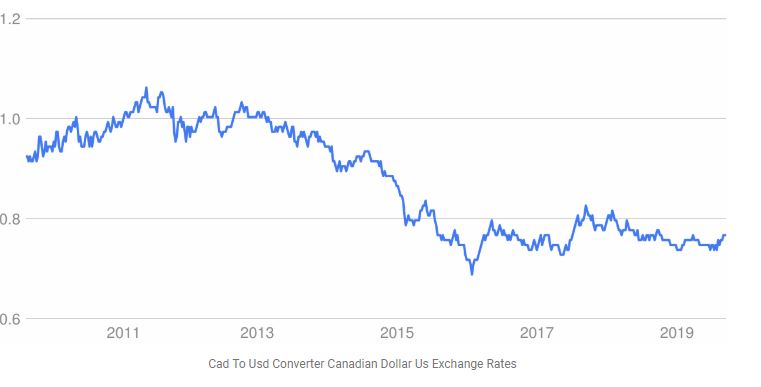
The far more lucrative option that I would recommend is to invest with the idea that the CAD is extremely likely to sink back to its average over a long enough time horizon. If you know anyone that smokes or drinks then the sin taxes you save on those products alone can be worth a short jaunt. The Canadian Border Services Agency (CBSA) allows you to head down to the states for 48 hours and return with $400 worth of goods for each person in your vehicle tax- and duty-free.
Cad vs usd how to#
So, if you’re like me, you’re probably wondering how to take advantage of this unique exchange rate situation right? Well, the first thing you can do is look seriously at cross border shopping. As Close To a Sure Thing As You’ll Get In Investing When you look at the relative size of the economies involved this seems fairly logical. Most analysts I’ve read, and a brief look at that statistics since 1971 (when the USD allowed itself to start “floating” independent of the gold standard), reveals that our natural exchange rate is likely somewhere between 80-85%. Eventually this cycle will go back around as it always does and our economy that is heavily dependent on petro dollars will shrink back to its average, while the American one will likely leap to the forefront again if it can ever solve its political gridlock problem. Our oil and other natural resources have given us some huge advantages and have allowed us to show strength at a time when few countries appear to have any. We haven’t yet noticed this dint because we are awash in commodity and energy dollars. In the bigger picture though, a higher dollar means that we can’t sell as many exports to the American consumer (the engine of the world economy) and with more and more “buy American” laws coming into play (despite their questionable legality), this is going to put a serious dint in our economy. It’s also nice to go on a shopping trip and get a lot of bang for your loonie/greenback. Long story short, we need the USA… a lot! When the dollar goes up, it definitely appeals to our “little brother” complex and it feels like we’re punching above our weight.

Over 80% of Canada’s population lives within 100 miles of the USA border and according to The World Factbook in 2007 over 84% of our exports go to our big brother to the south, and we receive over 56% of our imports from them. A few years ago (I couldn’t find anything to verify if this was true any longer) my political studies professor shocked us when he said there was more trade between the Detroit/Windsor port of entry than between any two countries in the entire world! That’s crazy when you think about it. Our trade relationship with the USA is still the biggest in the world. Two things that I believe most Canadians don’t realize in light of the last three years is that the Canadian dollar is artificially high right now, and that it isn’t good for the long-term health of our economy.

I even lost my hockey team (the Winnipeg Jets… who have since returned, thank god) in large part because of that dastardly exchange rate. Much of our shopping was done “across the line,” and the economies of the area were a very international mixture. Businesses and people that live near the USA border however, notice some fairly substantial differences in their life as our currency floats higher or lower against the USD. Sure, a few luxuries might cost a little more, but it won’t be anything noticeable.

After all, if you live in Canada and rarely travel outside of it, you probably don’t notice the effects of the changing exchange rate much at all. I find the whole idea of an equivalent e xchange rate very appealing to most Canadians in a patriotic sort of way. How cool is it to be a Canadian these days? I mean, we’re weathering the economic storm as well as any other G8 country, our banks are the envy of the world, and our dollar has been trading at par with the US Dollar for roughly three years now.


 0 kommentar(er)
0 kommentar(er)
